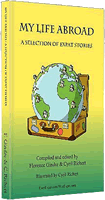Cars and Driving in Canada

Cars drive on the right side of the road in Canada. Automatic cars are more popular in Canada than manual drive or stick-shift cars.
Road rules in Canada vary by province. Driver’s examinations and licenses also vary by province.
All road signs in Canada give distances in kilometers and speeds in kilometers per hour (kph). Common speed limits for highways are 100 kph, and for residential areas, 30 or 50 kph.
Road signs in Canada are in English, except in Quebec where they are French, and New Brunswick where they are both French and English.
In most areas of Canada it is legal to turn right at a red light, except in Quebec, where it is illegal.
Pedestrians have the right of way at intersections and crosswalks, provided they are not crossing against a signal.
During winter, flashing blue or amber lights indicate snow removal vehicles. Many cities and communities instigate parking bans during the winter months to allow full road access to snow removal vehicles. Violators are fined or towed.
Parking in urban centers is generally metered, or free where no meters are present. Parking time limits are posted on signs. Parking violations are strictly enforced and penalized through fines, clamping, towing, and impounding. Parking in parking lots or spaces in urban cores can be very expensive. Parking spaces available to purchase or rent are often advertised online, through web sites such as Craigslist or Kijiji.
Toll roads exist throughout Canada. You can pay toll fees in cash at tollbooths, or in some instances you may purchase a toll pass. Some toll roads (such as Highway 407 in Ontario) read a transponder mounted on your car’s windshield, or take a photo of your car’s rear license plate if you do not have a transponder, and send you a bill in the mail. Tolls are often more expensive if your vehicle does not have a transponder. Tolls are also levied on some bridges in Canada.
Documentation
Driver’s licenses from all countries are valid in Canada for three months. Unless you have a Canadian or American drivers license, you should also obtain a one-year International Driving Permit before arriving in Canada. These are inexpensive and available from most motoring organizations.
When driving in Canada you must carry car registration papers, insurance papers, and rental contracts (if applicable).
Laws
Speed limits and road regulations are strictly enforced throughout Canada and punishable by fines, imprisonment, or the impounding of your vehicle. Repeat offenders are more harshly punished, and their driver’s license may be revoked.
By law, you must wear a seat belt in Canada and children must be seated in an appropriate child’s seat (regulations vary by province).
By law, all daytime running lights, break lights, and both turning indicators must be working at all times. If your lights are not working you may be fined.
You must always yield to police cars, fire trucks, and ambulances when their emergency lights are flashing. If they are approaching from behind you must pull to the right shoulder of the road and stop. In most of Canada drivers are required to slow down and move into a non-adjacent lane when passing a stopped emergency vehicle.
The use of hand held mobile devices is prohibited in cars in Canada. The use of hands-free devices is legal across Canada. Some provinces also have laws that ban all distracted driving activities, including the application of cosmetics, the consumption of food and drink, programming on-board GPS, or consulting maps while driving.
The national alcohol limit while driving is 0.08%. Drunk driving laws are strictly enforced in Canada. Violators are heavily prosecuted, fined, imprisoned, or deported. Passengers are not permitted to consume alcohol in vehicles in Canada. The legal drinking age in Canada is 19, except in Quebec, where it is 18.
Most provinces conduct random checks of drivers to check that they are complying with legal alcohol limits. These are normally randomly placed checkpoints, usually conducted at night. At a checkpoint a police officer will ask motorists if they have been drinking and gauge, based on their response and other factors, whether to initiate further roadside sobriety or breathalyzer tests.
Police officers may also check the license and registration of your vehicle at roadside check, as well as the expiry date of your vehicle’s annual safety inspection. It is highly recommended to keep your insurance, driver’s license, safety inspection sticker, and registration up to date to avoid penalties.
In some provinces, winter tires are required by law from October or December until March or April. Winter tires are absolutely necessary in Canada for driving in icy or snowy conditions. You can purchase and have winter tires installed at any garage.
Renting a vehicle
Major rental car companies have offices in all major cities and airports in Canada. Expect to pay $60/day for a small car and over $100/day for an SUV.
Most car rental companies provide a vehicle to you with a full gas tank. You must return the vehicle with a full gas tank.
You must purchase insurance when renting a vehicle, unless you have personal insurance or car insurance is covered through your credit card. Insurance generally costs $20 per day.
Charges apply if you have to drop off your rental car at different location than where you picked it up (e.g. office, airport). Car rental agencies provide free pickup and drop-off at major city hotels.
You must present a driver’s license and valid credit card when renting a car in Canada. Although the driving age across Canada is generally 16, you must be 25 to rent a car from most car rental companies in Canada. Companies who rent to drivers younger than 25 will charge a supplemental fee ($10-$25).
If you are under 25 you must provide proof of insurance, regardless of whether you are purchasing supplemental insurance from the car rental company, or if you have your own insurance coverage.
Child safety seats are compulsory in rental cars, and must be booked in advance. They cost approximately $10 per day.
Rental car companies may charge you an administrative fee on top of any toll fees you may incur on highways/motorways in Canada.
Pre-booked rental vehicles are usually cheaper than on-the-spot rentals.
Gas stations
Due to the popularity of cars in Canada you will never be far from a gas station. Most gas stations have full service and self-service options, and sell regular and premium gas, as well as diesel. You can also buy windshield washer fluid, antifreeze, oil, and other automobile products at gas stations.
Most gas stations also sell food, drinks, maps, lottery tickets, stamps, cigarettes, magazines, books, pet products, baby products, gift products, and household goods. Many gas stations also have cafes or restaurants.
The price of gas in Canada is indicated in dollars per liter ($/L). Depending on where you live, local authorities may regulate decreases and increases in price.
Maintenance & Tips
Maintenance and car repairs are offered at service stations and car mechanics throughout Canada. Car repairs in Canada can be quite costly, due to a high cost of labour. Cars should be serviced regularly. Due to the use of sand and salt on winter roads, cars should also be protected or treated for rust.
In the winter you must add antifreeze to your windshield washer fluid.
In the winter is it advised that you carry a survival kit in your car, in the event that you car breaks down or you get stuck in a storm. Survival kits should include rations, water, flares and/or flashlights, snow removal equipment, extra mobile phone battery, radio, first aid kit, blankets, traffic diversion cones/signs, emergency lights, medication, and extra clothing and footwear.
By Jess Gerrow, who traded city life in Canada for island life in the Mediterranean two years ago. She is a postgraduate marketing student, blogger, and freelance writer.
- My Life Abroad -
A selection of expat stories

"A fun compulsive read!"
J. Matcham, Amazon
"I strongly advise people ready to live abroad to read this book!"
Patrice, Amazon

 Driving: Life in the fast lane
Driving: Life in the fast lane